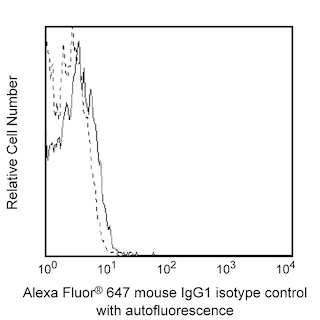-
Your selected country is
Middle East / Africa
- Change country/language
Old Browser
This page has been recently translated and is available in French now.
Looks like you're visiting us from {countryName}.
Would you like to stay on the current country site or be switched to your country?




Two-parameter flow cytometric analysis of CD263 (TRAIL-R3) expression on human peripheral blood leucocyte populations. Whole blood cells were stained with either Alexa Fluor® 647 Mouse IgG1, κ Isotype Control (Cat. No. 557714, Left Panel) or Alexa Fluor® 647 Mouse anti-Human CD263 antibody (Cat. No. 565458; Right Panel). The erythrocytes were lysed with BD Pharm Lyse™ Lysing Buffer (Cat. No. 555899). The two-parameter flow cytometric contour plots showing the correlated expression of CD263 (TRAIL-R3) [or Ig Isotype control staining] versus Side Light-scatter (SSC) signals were derived from gated events with the forward and side light-scatter characteristics of viable leucocyte populations. Flow cytometric analysis was performed using a BD™ Canto II Flow Cytometer System.


BD Pharmingen™ Alexa Fluor® 647 Mouse Anti-Human CD263 (TRAIL-R3)

Regulatory Status Legend
Any use of products other than the permitted use without the express written authorization of Becton, Dickinson and Company is strictly prohibited.
Preparation And Storage
Product Notices
- This reagent has been pre-diluted for use at the recommended Volume per Test. We typically use 1 × 10^6 cells in a 100-µl experimental sample (a test).
- Please refer to www.bdbiosciences.com/us/s/resources for technical protocols.
- The Alexa Fluor®, Pacific Blue™, and Cascade Blue® dye antibody conjugates in this product are sold under license from Molecular Probes, Inc. for research use only, excluding use in combination with microarrays, or as analyte specific reagents. The Alexa Fluor® dyes (except for Alexa Fluor® 430), Pacific Blue™ dye, and Cascade Blue® dye are covered by pending and issued patents.
- Alexa Fluor® 647 fluorochrome emission is collected at the same instrument settings as for allophycocyanin (APC).
- Alexa Fluor® is a registered trademark of Molecular Probes, Inc., Eugene, OR.
- Source of all serum proteins is from USDA inspected abattoirs located in the United States.
- Caution: Sodium azide yields highly toxic hydrazoic acid under acidic conditions. Dilute azide compounds in running water before discarding to avoid accumulation of potentially explosive deposits in plumbing.
- For fluorochrome spectra and suitable instrument settings, please refer to our Multicolor Flow Cytometry web page at www.bdbiosciences.com/colors.
- An isotype control should be used at the same concentration as the antibody of interest.
Companion Products





The B-D44 monoclonal antibody specifically recognizes CD263 which is also known as, TNF-related apoptosis-inducing ligand receptor 3 (TRAIL Receptor 3/TRAIL-R3), Decoy receptor 1 (DCR1), Lymphocyte inhibitor of TRAIL (LIT), or TRID. CD263 is a glycosylphosphatidylinositol (GPI)-anchored glycoprotein that belongs to the TNF Receptor Superfamily which includes other TRAIL (CD253/APO-2 Ligand) Receptors: CD261 (TRAIL-R1), CD262 (TRAIL-R2), and CD264 (TRAIL-R4). Unlike CD261 or CD262 that contain an intracellular signaling death domain, CD263 (and CD264) lacks a cytoplasmic death domain and is unable to transduce apoptotic signals upon binding TRAIL. CD263 thus serves as a decoy receptor for TRAIL. It functions as a negative regulator of apoptotic signaling by competing with CD261 and CD262 for the binding of TRAIL. Overexpression of CD263 can reportedly attenuate TRAIL-induced apoptosis.
Development References (6)
-
Baritaki S, Katsman A, Chatterjee D, Yeung KC, Spandidos DA, Bonavida B. Regulation of tumor cell sensitivity to TRAIL-induced apoptosis by the metastatic suppressor Raf kinase inhibitor protein via Yin Yang 1 inhibition and death receptor 5 up-regulation. J Immunol. 2007; 179(8):5441-5453. (Biology). View Reference
-
Bisgin A, Terzioglu E, Aydin C, et al. TRAIL death receptor-4, decoy receptor-1 and decoy receptor-2 expression on CD8+ T cells correlate with the disease severity in patients with rheumatoid arthritis. BMC Musculoskelet Disord. 2010; 11(192):200. (Biology). View Reference
-
Ch'en PF, Xu XG, Liu XS, et al. Characterisation of monoclonal antibodies to the TNF and TNF receptor families. Cell Immunol. 2005; 236(1-2):78-85. (Biology). View Reference
-
Gottwald L, Piekarski J, Kubiak R, et al. Membrane expression of TRAIL receptors DR4, DR5, DcR1 and DcR2 in the normal endometrium, atypical endometrial hyperplasia and endometrioid adenocarcinoma: a tissue microarray study. Arch Gynecol Obstet. 2013; 4(889):899. (Biology). View Reference
-
Mérino D, Lalaoui N, Morizot A, Schneider P, Solary E, Micheau O. Differential inhibition of TRAIL-mediated DR5-DISC formation by decoy receptors 1 and 2. Mol Cell Biochem. 2006; 26(19):7046-7055. (Biology). View Reference
-
Vermot-Desroches C, Sergent E, Bonnin B, Wijdenes J. Characterization of monoclonal antibodies directed against trail or trail receptors. Cell Immunol. 2005; 236(1-2):86-91. (Clone-specific: Flow cytometry). View Reference
Please refer to Support Documents for Quality Certificates
Global - Refer to manufacturer's instructions for use and related User Manuals and Technical data sheets before using this products as described
Comparisons, where applicable, are made against older BD Technology, manual methods or are general performance claims. Comparisons are not made against non-BD technologies, unless otherwise noted.
For Research Use Only. Not for use in diagnostic or therapeutic procedures.
Report a Site Issue
This form is intended to help us improve our website experience. For other support, please visit our Contact Us page.